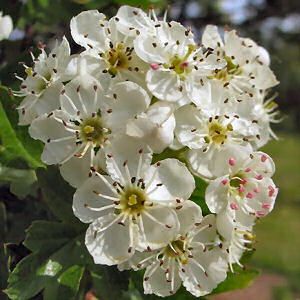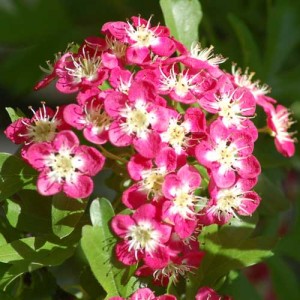Hawthorn (crataegus oxycantha) is a common deciduous tree or shrub growing primarily in North America, Europe, and western Asia. A member of the family Rosaceae, hawthorn's thorny branches sport beautiful pink or white flowers in the spring (hawthorn is also called "mayflower" or "maybush") which develop into small apple-like fruit that ripens bright red in the fall.
Hawthorn berries can be used in cooking much like other tree fruits (it smells like apples during the extracting process)
Hawthorn berries have been known as a natural heart tonic for centuries and has even been called "food for the heart."
 |
| Hawthorne Tree |
 |
| Hawthorne Flower |
 |
| Hawthorne Flower |
 |
| Hawthorne Berry |
Hawthorne Berries are rich in bioflavonoids, hawthorne berries have been used for
thousands of years in China to treat indigestion
and is widely known as a diuretic.
Part used: fruit
Properties: tonic, antispasmodic, astringent, diuretic, sedative.
What it affects: heart, circulation, nerves, and kidneys.
Preparation and amount:
Infusion: steep 5-15 min and drink 1 cup 2-3 x a day.
Decoction: simmer 5-15 min. and drink 6 oz. 3 x a day.
Tincture: drink 15-30 drops (1/2- 1 tsp) 3 x a day.
Fluid extract: take 10-15 drops 3 x a day.
Powder: take 10 #0 capsules (60) grains) 3 x a day.
Purposes:
This the herb for the heart! Internally, hawthorn normalizes blood pressure by regulating heart action. It indicates the coronary blood vessels. Those are the ones that nourish the heart itself. Taking the herb over a period of time will generally lower blood pressure. (Keep i mind that a key factor in lowering blood pressure is drinking enough water every day!). But it normalizes blood pressure, helping to elevate low blood pressure. It helps rapid or arrhythmic heartbeat, inflammation of the heart muscle (myocarditis), arteriosclerosis, and nervous heart problems. It is good for heart muscles weakened by age. Taking it regularly strengthens the heart muscle. It helps prevent hardening of the arteries; it is excellent for feeble heart action, valvular insufficiency, and irregular pulse.
Hawthorn tea is also excellent for nervous conditions, particularly insomnia. A decoction od the berries is best for sore throats and acid conditions of the blood. American Indians used it to treat rheumatism. In China, it is used to cure digestion.
Plant Description
The hawthorn grows as either a shrub or a tree in England and continental Europe. It is widely grown as a hedge plant. Its trunk or stem have hard wood, smooth and ash-gray bark, and thorny branches. The small, shiny leaves are dark green on top, light bluish green underneath, and have three irregularly toothed lobes. The white flowers have round petals and grow in terminal corymbs during May and June. The fruit or haw is a 2 to 3 seeded, scarlet on the outside, yellowish and pulpy on the inside.
The hawthorn grows as either a shrub or a tree in England and continental Europe. It is widely grown as a hedge plant. Its trunk or stem have hard wood, smooth and ash-gray bark, and thorny branches. The small, shiny leaves are dark green on top, light bluish green underneath, and have three irregularly toothed lobes. The white flowers have round petals and grow in terminal corymbs during May and June. The fruit or haw is a 2 to 3 seeded, scarlet on the outside, yellowish and pulpy on the inside.
No comments:
Post a Comment